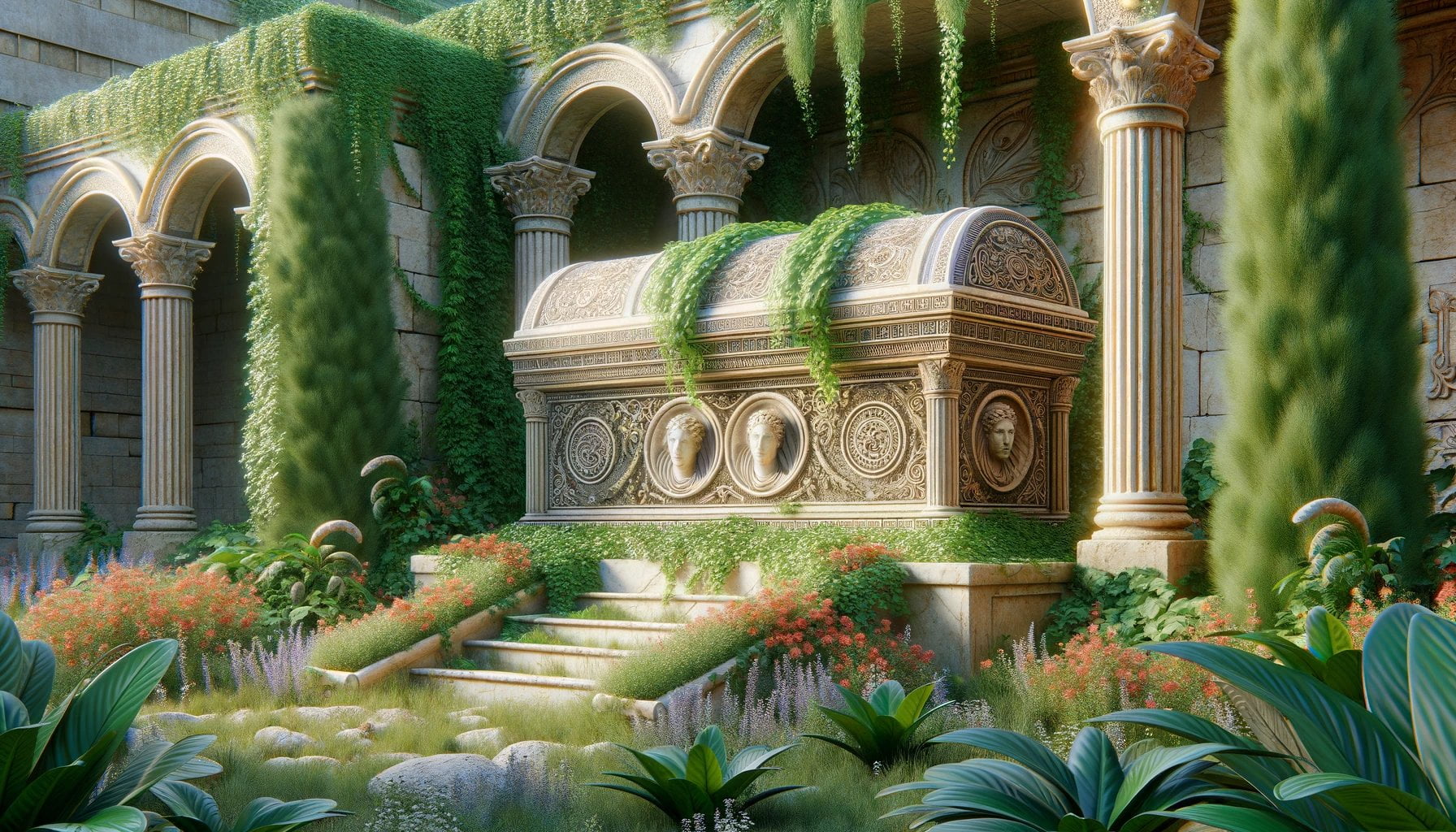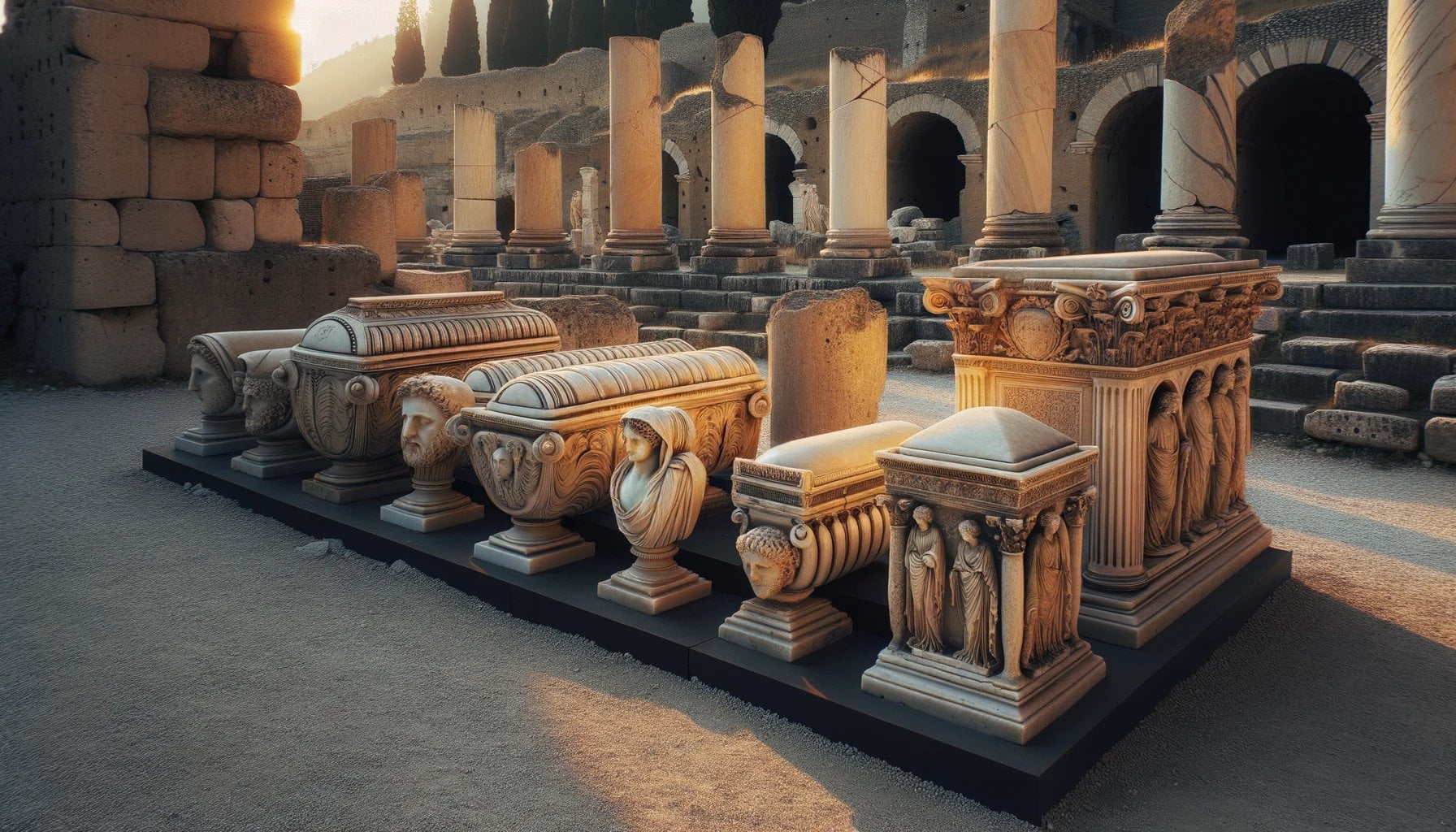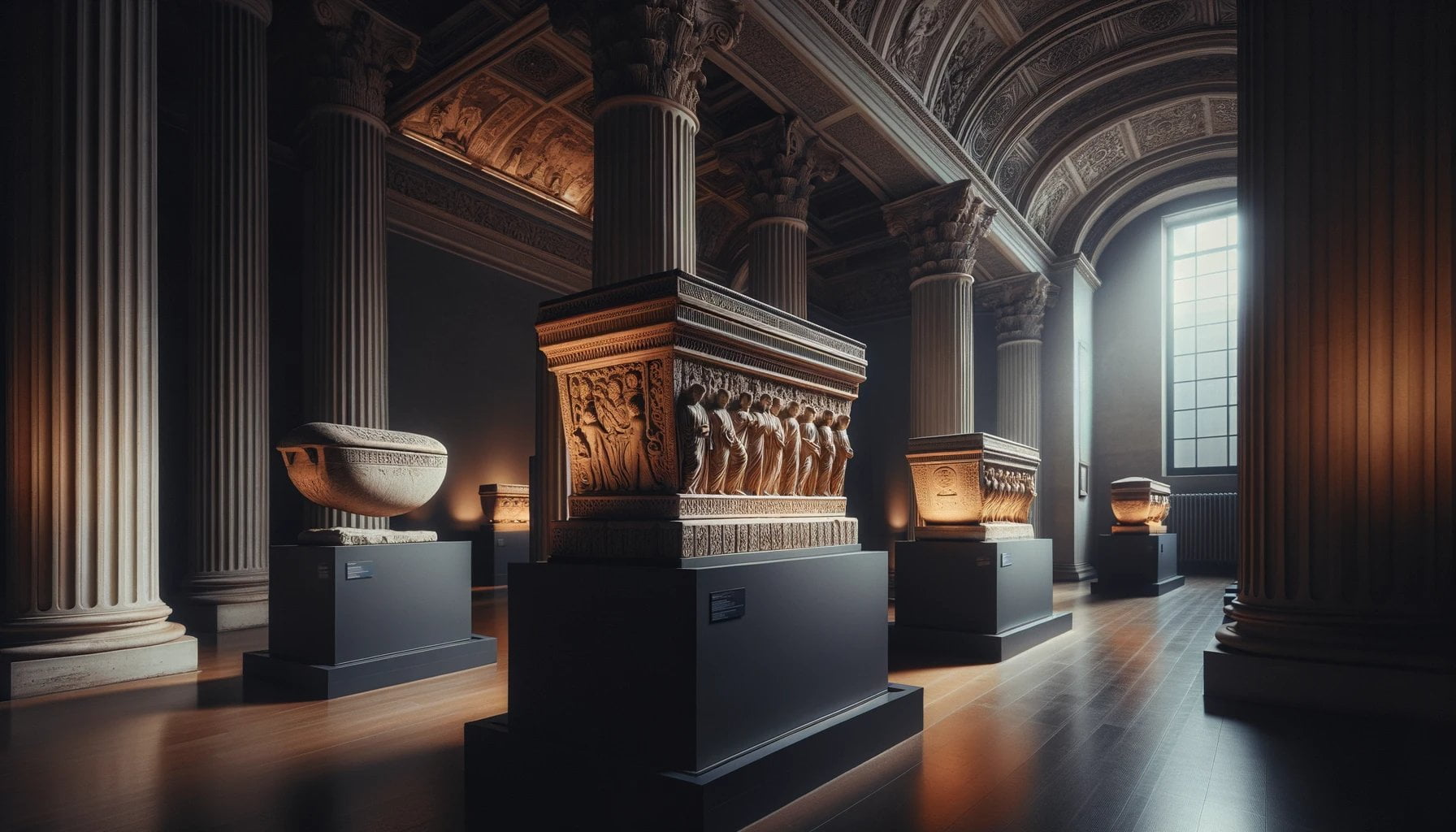Discover the enigmatic world of ancient Roman sarcophagi as we delve into their meaning, themes, and imagery. In this article, we will explore the captivating artistry and funeral practices of ancient Rome, focusing on the large-scale sarcophagus from Perge at the Archaeological Museum of Antalya, and the intricate lid of a sarcophagus from Ephesus at the Archaeological Museum of Izmir. Join us on a journey to unravel the mysteries behind these mesmerizing stone coffins, shedding light on their symbolism, craftsmanship, and cultural significance.

Key Takeaways:
- Sarcophagus, meaning “flesh-eater” in Greek, is a stone coffin used for inhumation burials in the Roman Empire from the second century A.D. onwards.
- Sarcophagi were commissioned by various individuals, including the elite, children, families, and wives.
- These coffins were intricately carved with scenes from mythology, history, or daily life.
- The oldest sarcophagi were discovered in the Etruscan city of Caere (now Cerveteri, Italy).
- Sarcophagi were made of various materials, such as marble, other stones, lead, and wood.
- Over 10,000 Roman sarcophagi have survived, potentially representing as many as 20,000.
- Personalization of sarcophagi through art and inscriptions allowed the display of the attributes, achievements, or history of the deceased.
- The use of sarcophagi for burial began in the second century and gradually gained acceptance among the lower classes.
- The shift towards inhumation burial may have been influenced by the belief that it was a gentler and less disturbing burial rite.
Ancient Roman Sarcophagi
Sarcophagi, meaning “flesh-eaters” in Greek, are stone coffins that were widely used for burials in ancient Rome. These ornately crafted coffins provide invaluable insights into the artistry and funeral practices of the Romans. Let’s delve into the intriguing world of ancient Roman sarcophagi and unravel their mysteries.
The Symbolism of Ancient Roman Sarcophagi
Ancient Roman sarcophagi were not mere burial containers; they were intricate works of art filled with symbolism. Carved with scenes from mythology, history, or daily life, these sarcophagi communicated the deceased’s attributes and achievements. The depictions served as a visual storytelling device, capturing the essence of the individual’s life and conveying their importance even in death.
Craftsmanship and Materials
The craftsmanship displayed on ancient Roman sarcophagi is awe-inspiring. The most luxurious examples were crafted from marble, showcasing the wealth and status of the individuals buried within. However, materials such as other stones, lead, and wood were also utilized. The meticulous attention to detail and skill of the artisans can still be admired today, despite the passage of centuries.
Significance and Cultural Practices
Ancient Roman sarcophagi were not exclusive to the elite alone. They were commissioned by individuals from various walks of life, including children, families, and wives. The practice of using sarcophagi for burials gradually gained acceptance among the lower classes. This change in burial practice may have been influenced by the belief that inhumation, as opposed to cremation, offered a kinder and less disturbing burial rite.
Preservation and Evolution
Remarkably, thousands of ancient Roman sarcophagi have survived through the ages. Fragments discovered by archaeologists hint at the possibility that even more sarcophagi await rediscovery. The preservation of these burial artifacts allows us to delve into the history, art, and cultural practices of ancient Rome. Each sarcophagus serves as a tangible link to the past, preserving the stories and rituals of a bygone era.
In conclusion, ancient Roman sarcophagi are more than stone coffins. They are windows into the lives, beliefs, and aspirations of the deceased. Through the study and analysis of these remarkable artifacts, historians can uncover fascinating details about ancient Roman society, its art, and its funeral practices. The mysteries they hold continue to captivate and enthrall us, providing a glimpse into the intricate tapestry of the ancient world.
Ancient Roman sarcophagi were often adorned with intricate carvings depicting scenes from music ancient Rome, ancient Roman temples, and ancient Roman sports. If you’re curious to learn more about these fascinating aspects of Roman culture, click here to explore the musical heritage of ancient Rome, here for a glimpse into the grandeur of ancient Roman temples, and here to discover the thrilling world of ancient Roman sports.
Archaeological Museum of Antalya: Large-Scale Sarcophagus from Perge – Rear Side
The Archaeological Museum of Antalya offers a mesmerizing glimpse into the rich cultural heritage of ancient Rome. Among its notable exhibits is the large-scale sarcophagus from Perge, which dates back to the 3rd century. This ornately carved stone coffin provides valuable insights into the artistry and funeral practices of the Romans.
Unveiling the Rear Side of the Sarcophagus
When we turn our attention to the rear side of this magnificent sarcophagus, a whole new world of intricate carvings and symbolism unfolds before our eyes. Here, we are presented with a tapestry of images that depict scenes from ancient mythology. The craftsmanship displayed is nothing short of awe-inspiring.
Exploring the Symbolism
Many ancient Roman sarcophagi were not merely burial containers but also works of art meant to convey the attributes and achievements of the deceased. The rear side of the Perge sarcophagus is no exception. It invites us to unravel the rich symbolism embedded in its carvings. Each scene carefully carved into the stone tells a story, serving as a lasting memorial to the individual laid to rest within.
Delving into Ancient Mythology
As we examine the rear side of the sarcophagus, we encounter a myriad of mythical beings and legendary figures. These carvings transport us to the realms of ancient mythology, where gods, goddesses, heroes, and creatures of lore come to life. It is as if the stone itself holds the key to unlocking the mysteries of the past.
A Portal to Ancient Roman Culture and History
Studying the large-scale sarcophagus from Perge at the Archaeological Museum of Antalya offers us a captivating journey into ancient Roman culture and history. Through meticulous research and interpretation, historians have uncovered fascinating details about the society, art, and funeral practices of ancient Rome. This sarcophagus stands as a tangible link to a bygone era, preserving the stories and rituals of those who passed away centuries ago.
Key Takeaways:
- The Archaeological Museum of Antalya houses the large-scale sarcophagus from Perge, offering insights into ancient Roman funeral practices.
- The rear side of the sarcophagus showcases intricate carvings depicting scenes from ancient mythology.
- The symbolism embedded in the carvings provides a glimpse into the attributes and achievements of the deceased.
- The sarcophagus serves as a portal to ancient Roman culture and history, preserving the stories and rituals of a bygone era.
Sources:
- Wikipedia: Antalya Museum – source
- Antalya Tourist Information: Antalya Archaeological Museum – source
Archaeological Museum of Izmir: Lid of a Sarcophagus from Ephesus – Details
Welcome to the fascinating world of ancient Roman sarcophagi! In this article, we will explore the intriguing lid of a sarcophagus from Ephesus, showcased at the renowned Archaeological Museum of Izmir. Get ready to delve into the details of this ancient funerary artwork and uncover the stories it holds.
The Archaeological Museum of Izmir, located in the vibrant city of Izmir, Turkey, houses an impressive collection of artifacts from the Hellenistic and Roman periods. Among its treasures are various sarcophagi that offer unique insights into the ancient Roman culture and funeral practices.
One of the notable highlights within the museum’s collection is the lid of a sarcophagus from Ephesus. This captivating piece is believed to be from the Roman period and is displayed alongside other sarcophagi, creating a mesmerizing journey into the past.
The Lid of the Ephesus Sarcophagus: A Window into Ancient Roman Artistry
As you stand before the lid of the sarcophagus from Ephesus, you can’t help but marvel at its intricate craftsmanship. Carved from luxurious marble, this lid is a testament to the skill and artistry of ancient Roman sculptors. Every detail, every delicate curve, tells a story of the individual whose remains rested within it.
Gently running your hand over the smooth surface of the lid, you can feel the traces of ancient legends and Roman history. Scenes from mythology, daily life, and historical events are meticulously etched into the marble, whispering tales of the deceased’s attributes and achievements.
Unveiling the Symbolism
The lid of the Ephesus sarcophagus is not merely a burial container; it is a work of art laden with symbolism. Each carving on its surface carries a deeper meaning, merging the realms of life, death, and myth.
As your eyes move across the lid, you’ll encounter gods, heroes, and mythical creatures, all intertwined in a dance of narratives. These scenes were carefully selected to honor and represent the virtues and accomplishments of the deceased. Step into the world of symbolism as you decipher the messages conveyed through these remarkable carvings.
The Rich Landscape of Ancient Roman Funeral Practices
The lid of the sarcophagus from Ephesus offers a profound insight into the funeral practices of ancient Rome. It reveals the significance that art held in commemorating and memorializing the deceased. The ornate carvings on the lid not only served as a tribute to the individual but also as a way to communicate their standing in society and their connection to ancient legends and history.
It is fascinating to contemplate the cultural and religious beliefs that shaped these funerary artworks. Each sarcophagus was a product of the time and place it was created, reflecting the influence of Roman traditions, Hellenistic artistry, and individual aspirations.
Exploring the Archaeological Museum of Izmir
The Archaeological Museum of Izmir stands as a cultural beacon, attracting enthusiasts and scholars from all over the world. Its diverse collection, encompassing statues, steles, and inscriptions, provides a comprehensive view of ancient Roman and Hellenistic cultures.
As you wander through the corridors of this esteemed museum, you will discover a wealth of history waiting to be unraveled. The garden itself is adorned with statues uncovererd from archaeological excavations, inviting you to immerse yourself in the marvels of the past.
Key Takeaways:
– The Archaeological Museum of Izmir in Turkey showcases a remarkable collection of artifacts from the Hellenistic and Roman periods.
– Among its treasures are various sarcophagi that shed light on ancient Roman funeral practices and artistry.
– The lid of a sarcophagus from Ephesus is a captivating exhibit in the museum, carved with scenes from mythology, history, and daily life.
– This sarcophagus lid provides insights into the symbolism and cultural significance attached to ancient Roman funerary art.
– By exploring the lid of the Ephesus sarcophagus, visitors can uncover a deeper understanding of ancient Roman society, its beliefs, and its artistic achievements.
Citation:
– Turkish Museums: İzmir Archaeology Museum
– Wikimedia Commons: Category: Ancient Roman sarcophagi in the Izmir Archaeology Museum

FAQ
Q1: What is a sarcophagus?
A1: A sarcophagus is a stone coffin used for inhumation burials throughout the Roman empire from the second century A.D. onwards. It is often elaborately carved with scenes from mythology, history, or daily life.
Q2: Who commissioned Roman sarcophagi?
A2: Roman sarcophagi were commissioned by both the elite of Roman society and individuals from lower classes, including children, families, and wives.
Q3: What materials were used to make sarcophagi?
A3: The most luxurious sarcophagi were made of marble, but they were also made of other stones, lead, and wood.
Q4: How many Roman sarcophagi have survived?
A4: At least 10,000 Roman sarcophagi have survived, with fragments possibly representing as many as 20,000.
Q5: What do sarcophagi reveal about the deceased?
A5: Sarcophagi were often personalized to display the attributes, achievements, or history of the deceased through art and inscriptions.
- China II Review: Delicious Food & Speedy Service - April 17, 2025
- Understand Virginia’s Flag: History & Debate - April 17, 2025
- Explore Long Island’s Map: Unique Regions & Insights - April 17, 2025
















